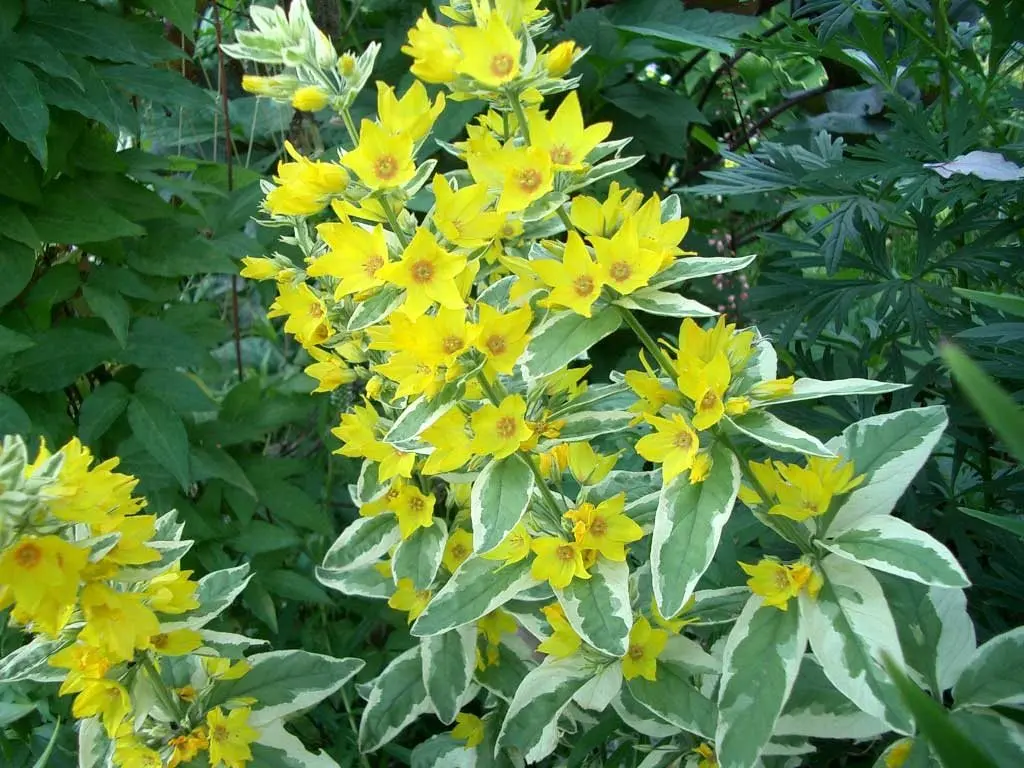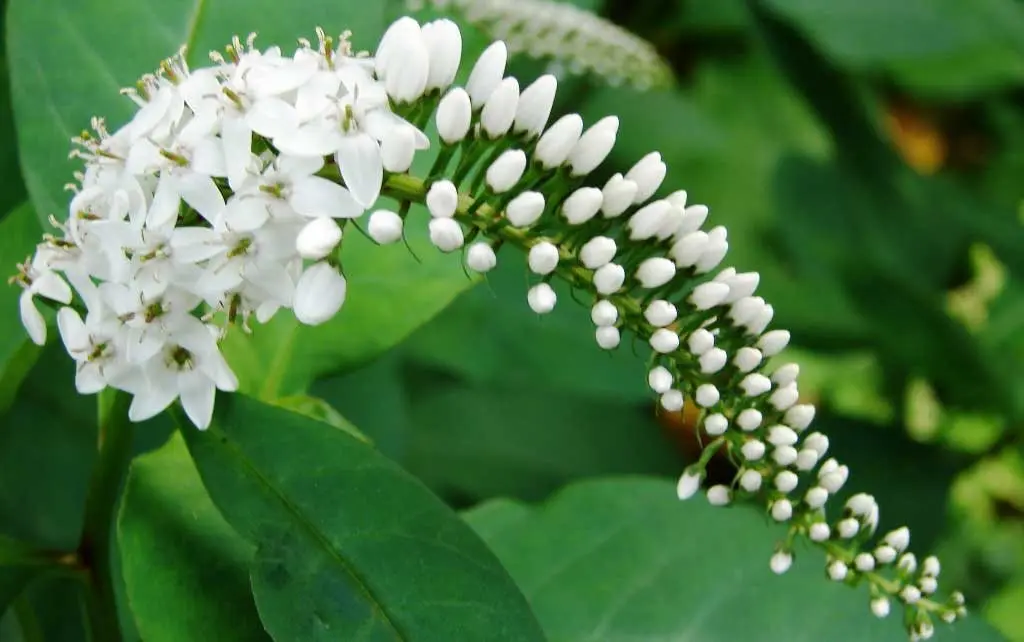Contents
- Properties and application of loosestrife coin, point
- Botanical characteristics of loosestrife
- loosestrife flowers
- Verbainik dot
- Common loosestrife
- Verbeinik Beaujolais
- loosestrife lily of the valley
- Spotted loosestrife Lysimachia
- Verbeinik “Alexander”
- Purple loosestrife
- loosestrife
- Useful properties of loosestrife
- The use of loosestrife
- Contraindications to the use of loosestrife
Properties and application of loosestrife coin, point
Botanical characteristics of loosestrife
Loosestrife Monetary – a perennial herbaceous plant with creeping stems up to 80 cm long. The stems are tetrahedral, slightly branched, roots grow in places of nodes, growing into the soil. The leaves of the plant are opposite, rounded, entire along the edge with short petioles. Golden-yellow, large, solitary axillary flowers are distinguished by a funnel-shaped calyx, separate to the very base. The flowering period of the plant is June-July.
The coined loosestrife reproduces vegetatively. The plant prefers damp places, grows in water meadows, in thickets of bushes, it can be seen on the outskirts of swamps. The plant’s leaves are similar to willow leaves, hence the Russian name is loosestrife.
Flowers grow well on fertile soils, they prefer shade. They are unpretentious, with sufficient humidity grow, turning into luxurious plants. In the cold season, loosestrife is placed in winter gardens.
loosestrife flowers
Looseflower flowers are useful and aesthetically beautiful. There are many varieties of this species, growing in the wild and naturalized, adapted to different climatic conditions of various natural zones. This is an excellent medicinal raw material used in folk medicine and as a decoration for lawns and balconies in the summer.
Verbainik dot
Point loosestrife has a light brown long rhizome, branched at the end and forming a whorl of 4-6 underground shoots. The pubescent stem is erect, with a small number of branches and sessile broadly lanceolate leaves. Lemon-yellow flowers are placed at the top of the stem in large numbers.
This species grows on any soil, but slightly acidic light and medium loams are an ideal environment for the normal development of the plant. In nature, spotted loosestrife is found in the forests of Central and Western Europe with moist soil. Blooms from June to July (30-35 days). The plant looks spectacular in composite plantings near artificial reservoirs and in mixborders.
Common loosestrife
Common loosestrife is perfect for landscape design. This species blooms with small bell-shaped flowers collected in paniculate inflorescences at the end of June. The petals are yellow, shiny, reddish-brown at the base of the corolla, attracting insects for pollination. The plant is a good honey plant.
Common loosestrife has astringent, choleretic, tonic, anti-inflammatory properties. An infusion of herbs is drunk with convulsions, general weakness, with hemoptysis and bleeding. An infusion of vodka is taken for jaundice and liver diseases: 2 tablespoons of common loosestrife grass are infused for several days in a glass of vodka, 20 drops diluted in a glass of water are consumed 3 times a day before meals.
Verbeinik Beaujolais
Beaujolais loosestrife is a rhizomatous perennial plant. An unusual perennial with a height of 45–90 cm has a delightful appearance. Wine-red, almost black flowers of the plant are collected in spikes. Silvery-green lanceolate leaves have a slight corrugation along the edge. For this type of loosestrife, fertile garden soils are preferred; plants are used as borders, arrays, and for tamping bushes.
loosestrife lily of the valley
The loosestrife lily of the valley has a straight, furrowed, leafy stem. An adult plant reaches a height of 45 cm. This species is interesting in spike-shaped inflorescences with small star-shaped white flowers located at the top of the stem. The leaves are alternate, glaucous below, with a surface dotted with dots.
This species grows in mountain forests, in dry meadows of the Far East. In Primorye, 2 more species grow: densely spiked loosestrife (very similar to lily of the valley, the same height, but more decorative) and yellow-flowered Dahurian loosestrife (up to 1 m high).
The roots of loosestrife contain saponins, triterpene compounds and are used in the recovery of the body after suffering hemorrhages and bleeding.
Spotted loosestrife Lysimachia
Spotted loosestrife Lysimachia is used in folk medicine in the form of infusions for diarrhea, jaundice, and scurvy. Crushed fresh leaves of the plant heal poorly healing wounds. The plant contains a large amount of saponins, because of this, it is not of interest to animals. Incredibly beautiful flowers allow the use of loosestrife in landscape design, it is unpretentious in care and grows rapidly.
Verbeinik “Alexander”

This herbaceous perennial, reaching a height of 40-50 cm, with sessile broad-lanceolate leaves, has lemon-yellow flowers, collected in large numbers on a slightly branched top of the stem. This species blooms for 30-35 days in June-July. It develops luxuriously only in sunny areas with fertile soil. Excellent combined with other plants in group plantings near ponds and in mixborders. When designing flower beds, it must be taken into account that this plant has a curtain that quickly grows in diameter and displaces less hardy plants.
Purple loosestrife
Purple loosestrife is a perennial rhizomatous plant with attractively colored leaves and inflorescences. It forms small bushes with upright shoots. This species has a broadly lanceolate, smooth leaf blade. Yellow, with a red “eye” in the center of the corolla, small flowers are collected in sparse inflorescences at the tops. The plant is photophilous, loves moisture, grows poorly on “poor” soils.
loosestrife
The loosestrife is endowed with erect stems 45 cm tall. Its leaves are paired, wine-red, broadly lanceolate. At the ends of the stems and in the axils of the upper leaves, small lemon-yellow flowers are formed, collected in a loose inflorescence. The flowering period of this species is August-September. The plant loves sunny areas, is used in contrasting flower beds, frost-resistant. A wild plant chooses meadows, edges, glades. The birthplace of the loosestrife is North America.
Useful properties of loosestrife
The loosestrife has been famous for its useful properties since ancient times. The presence of hyperin, rutin, phenolcarboxylic acids and their derivatives in the roots, leaves and flowers has been scientifically confirmed. The content in the plant of the enzyme primverase, silicic acid was revealed. All parts of the plant contain saponins, tannins, carbohydrates, nitrogen-containing compounds.
The use of loosestrife

In folk medicine, loosestrife has found wide application. With various gastrointestinal diseases, the plant is the first assistant on the path to recovery. Bites of animals, snakes, insects will not be painful and will not cause complications if you start taking loosestrife-based products in time and apply dressings soaked in fresh juice. Skin inflammation, some types of eczema, and thrush are excellently treated with loosestrife. Those suffering from dust lung disease tend to find it difficult to clear their throats; in order to be able to easily get rid of mucus, they are recommended to use loosestrife in the form of tea.
Young stems of the plant are used for infusions and decoctions, in combination with honey it is an excellent medicine for coughs and shortness of breath. Dry roots, ground into powder, effectively heal wounds, reduce pain during various inflammations, and stop bleeding in case of damage to blood vessels. Infusions and decoctions of loosestrife are used for constipation, bruises, peptic ulcer, gynecological diseases, anemia, scurvy, migraine. Rapid resorption of tumors, swelling with bruises, elimination of hernias.
Contraindications to the use of loosestrife
Loosestrife is contraindicated in certain blood diseases, it is dangerous to take funds based on loosestrife for thrombosis, varicose veins, sclerosis of the vessels of the extremities. It is also not recommended to use the plant for patients suffering from hypertension. You can not give decoctions of herbs for the treatment of dry cough to children.









